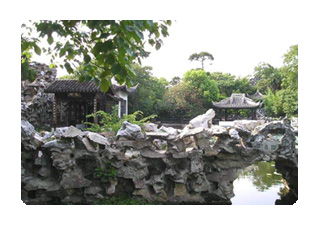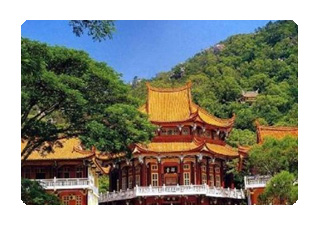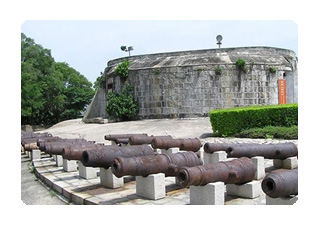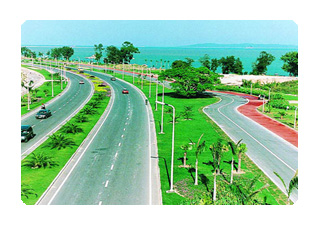Xiamen is located in the southeast of Fujian province,
adjacent to Zhangzhou at west and Quanzhou at north,
face the Kinmen Island across the sea at southeast.
It's one of the first five special economic zones
and the ''beautiful garden on sea''.
The main languages are Taiwanese dialect, Mandarin
and others. As the beautiful natural scenery and tidy
environment, Xiamen was rewarded the tile of ''International
Garden City'', ''National Environmental Protection
Model City'', ''Chinese Outstanding Tourism City'',
''United Nations Habitat Award'', ''National Civilized
City'' and others.
Xiamen belongs to the subtropical climate, mild and
rainy, rich in sunny, and the flowers & forests
flourish all year around. Except the typhoon season
in August, other times are very suitable to tour.
At there, the unmissed spots are Gulangyu, Xiamen
University, Nanputuo Temple and around island road.
You will be surprised for local coastal scenery, tropical
plants and unique construction style.
Refer to shopping place, you can go to Zhongshan road,
Longtou road, Bailuzhou shopping mall, Hubing middle
road and other traditional shopping areas. Tasting
the peanut soup, oysters fried noodles paste, brisk
side on Snack Street or feasting on the authentic
Taiwanese cuisine.
 Jimei
Jimei
At the northe end of the Gaoqi-Jimei Sea Dyke lies
the town of Jimei. Surrounded by the sea on three
sides, the town is known for its magnificent buildings
and postcard-like sites, which include Aoyuan Garden,
Yangping Fortress, and Xiamen Sea Dykes.
Aoyuan Garden is where the local celebrity Tan Kah
Kee was buried. Tan Kah-kee, who is originally from
Jimei, founded Xiamen University in 1913. He then
went on to build a kindergarten, a science centre,
a library and several other schools teaching various
subjects, tuing Jimei from a rural village into a
sizeable town. Aoyuan Garden includes a 50 meter long
corridor, a monument, and the Mausoleum of Tan Kah
Kee. On the stone railings are relief sculptures depicting
the life of this great patriot. The walls on both
sides of the corridor have carvings of more than 40
pictures relating to the lives of other Chinese historical
figures. A pagoda shaped stone monument is erected
in the center of the garden.
Yanping Fortress was built by General Zheng Chenggong
to stand atop a cliff overlooking the sea on the southe
side of Jimei. The site now lies in ruins except for
one solitary door and rusty cannon.
The Xiamen Sea Dykes are linked to the mainland by
the Gaoqi-Jimei and Jimei-Xinglin Sea Dykes. Both
dykes are open to traffic and are used by trains,
automobiles and pedestrians alike. In 1991 a new highway
bridge was built to the northeast of the Gaoqi-Jimei
Dyke, which is the first land-sea bridge in China.
Gulangyu Island
Gulangyu Island is one of the most attractive landscapes
among the attractions found in Xiamen.
 Southern
Putuo Temple
Southern
Putuo Temple
South Putuo Temple is situated at the foot of Wulao
Peak and lies on the southe end of Xiamen. The temple
was first built more than a thousand years ago during
the Tang Dynasty and is famous throughout Fujian as
a sacred place for Buddhism. It is called South Putuo
for its conformity to Guanyin (Goddess of Mercy) and
Bodhisattva (Buddhist seeker of enlightenment) as
well as its Bodhimandala (a place where a Bodhisattva
has achieved 'Buddha hood').
South Putuo temple has a total area of 25.8 hectares
and is spread out over the mountain's slope. From
the north to the south lie the Hall of Heavenly Kings,
the Precious Hall of Great Heroes, the Hall of Great
Mercy, and the Buddhist Scripture Garret. There are
annexes on both sides which include corridors, the
Bell and Drum Towers, Haihui Hall, Puzhao Hall, Taixu
library, and classrooms that are part of the Buddhist
Institute.
During recent years, to the south of the Hall of Heavenly
Kings lie the Free Life Pond, two newly built Longevity
Towers, two pavilions, and a lotus pond. Between the
two ponds is the Seven Buddha Tower, which is composed
of seven statues of Buddha, including Sakyamuni and
Kasyapa. The Longevity Towers have 11 layers in the
style of Buddhist buildings of South Asia, contributing
to the diverse architecture of South Putuo Temple.
The noteworthy Buddhist Institute of Southe Fujian
is situated in the temple, which was established in
1925 and is the earliest Buddhist Institute established
in China. The Buddhist Institute started the school
up again in 1985, and established Yangzheng College,
consisting of a formal two-year preparatory class.
It also set up an additional two-year research class.
The Buddhist Institute is influential throughout China
ad well as Southeast Asia.
 Hulishan
Fortress
Hulishan
Fortress
Hulishan Fortress is an inteationally recognized historical
and cultural site. The Fortress, built in 1894 during
the 20th year of Emperor Guangxu's reign, has more
than 100 years of history. In August, 2000, it was
listed in 'The Guinness Book World Records'. The base
of the fortress is made of a strange yet surprisingly
strong mixture of camphor tree sap, liquid brown sugar,
glutinous rice, clay, and sand. The fortress includes
barracks, a secret tunnel, commanding tower, sentry
platform, ammunition depot, trenches, and castle.
The castle is rectangular shaped and is made of granite
rocks, occupying an area of 13,000 square meters.
In recent years, the fortress yard has been newly
cleaned up and large-scale wall carvings have been
built, which demonstrates the course of warehousing
weapons, reviving military forces, and resisting strong
enemies. Behind the wall carvings there is a small
garden that features sculptures interspersed with
interesting plants like evergreen grass and golden
ball cacti. A sightseeing pavilion built in the high
place appears harmonious and its natural surroundings.
The scenic spot of Moonlight Rock can be found in
the north of the small garden with other attractions
like 'Dragon Spring Waterfalls', 'A Line Sky', and
'The Poem Wall of Hulishan Fortress'.
 Island
Ring Road
Island
Ring Road
The Island Ring Road was recognized in the year 2000
as one of the 20 most famous scenic spots in China,
and is included in the 9 kilometers stretch of coastline
that runs between Xiamen University and Qian Pu, called
the Golden Coastline, which serves to integrate tourism,
sightseeing, and recreation. It is about 31 kilometers
in length, 44-60 meters in width, and is equipped
with 6 dual tu lanes. The Island Ring Road is one
of the main strategic and scenic roads in Xiamen.
The construction of the Island Ring Road adhered to
the principle of 'facing the sea and leaving the most
beautiful beach for the people'. It fully complements
and brings to life the area's sub-tropical landscape.
At the end of 1999, the 10 kilometer section of highway
between the Huli Hill Fortress and Xiamen Inteational
Exhibition Center was completed. This area can be
divided into four sections: Zeng Cuo An, Tai Yang
Wan, (Sun Bay) Huang Cuo, and Qian Pu. The Zeng Cuo
An Comprehensive Tourist Service Center, Huang Cuo
Tourist Service Center, and Qian Pu Exhibition Centre
can also be found along the road.
The shoreline facing Taiwan-controlled Jinmen boasts
a beautiful landscape, and with good binoculars you
can see soldiers on patrol, a mere 3 miles offshore.
Lawns and gardens, and paths for hikers, bicyclists
and roller bladders can all be found on this road.
Catch the action on the eve of the Lante Festival
and Mid-autumn Festival, when both Jinmen and Xiamen
set off spectacular fireworks.
Take a bus or taxi to one of the picnic areas and
have lunch on the broad grassy lawns that are near
the miles of beaches. Enjoy the sand and surf with
the backdrop of islands and freighters, or you may
skip the picnic and have tea or a meal by the beach,
where you can rent beach umbrellas, floats, mats,
and boats.



